ELCI
Safety concerns have been raised over the last decade over the Electrical
Shock Hazards that have been associated with municipal and roadway
lighting systems. Insulation breakdown from aging infrastructure has been
documented from coast to coast (see these articles for reference), along
with missing access covers, animal penetration, wind damage, water damage,
and salt corrosion. Implementing the use of an ELCI will help eliminate
these hazards and reduce the liability associated.
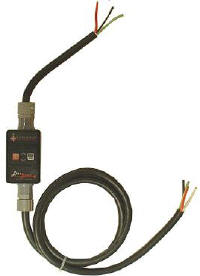 ELCI
stands for "Equipment (sometimes "Earth") Leakage Circuit Interrupter",
and is a device intended to mitigate ground fault leakage specifically for
the protection of equipment. A "GFCI" (Ground Fault Circuit Interrupter)
is essentially the same as an "ELCI", but for the most part differ in trip
threshold of leakage current and/or circuit voltage. A "GFCI" indicates
that "Personnel" protection is being provided. This calls for a trip
threshold of 4 to 6 mA with a maximum response time of 25ms and circuit
voltage from any single current carrying conductor to Ground cannot exceed
150V. Thus, even if a 4 to 6 mA trip threshold is employed, on a 480V
circuit, or even a 240V elevated (L1, N), providing personnel protection
is not feasible. In order to provide personnel the greatest level of
protection given circuit criteria, use of an "ELCI" is prescribed for
personnel protection. Other applications for "ELCI" devices may call for
higher trip thresholds of 10, 30, or even 100mA as baseline leakage as
some of these applications may well exceed 6mA when a load device is
functioning properly. ELCI
stands for "Equipment (sometimes "Earth") Leakage Circuit Interrupter",
and is a device intended to mitigate ground fault leakage specifically for
the protection of equipment. A "GFCI" (Ground Fault Circuit Interrupter)
is essentially the same as an "ELCI", but for the most part differ in trip
threshold of leakage current and/or circuit voltage. A "GFCI" indicates
that "Personnel" protection is being provided. This calls for a trip
threshold of 4 to 6 mA with a maximum response time of 25ms and circuit
voltage from any single current carrying conductor to Ground cannot exceed
150V. Thus, even if a 4 to 6 mA trip threshold is employed, on a 480V
circuit, or even a 240V elevated (L1, N), providing personnel protection
is not feasible. In order to provide personnel the greatest level of
protection given circuit criteria, use of an "ELCI" is prescribed for
personnel protection. Other applications for "ELCI" devices may call for
higher trip thresholds of 10, 30, or even 100mA as baseline leakage as
some of these applications may well exceed 6mA when a load device is
functioning properly.
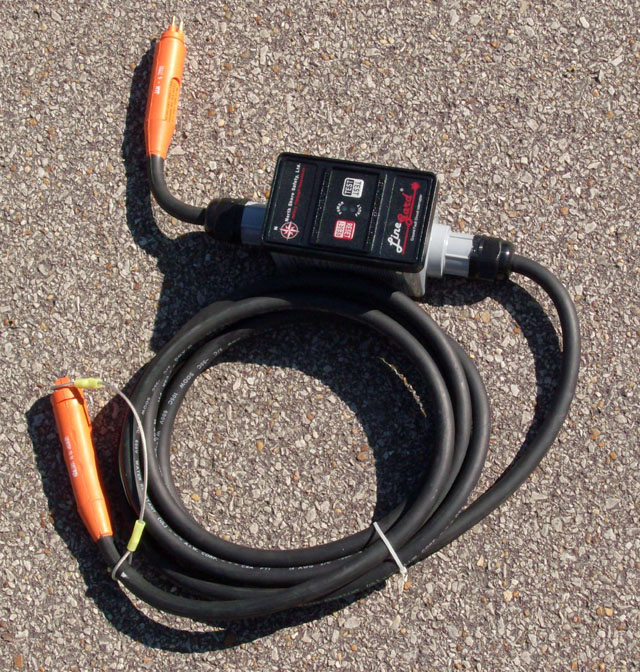 An
ELCI can easily be employed or retrofitted into existing MG Squared
DOTPLUG systems. In fact, in Miami Dade County Florida, hundreds of DOTPLUG systems have been either ordered or retrofitted with ELCI systems. An
ELCI can easily be employed or retrofitted into existing MG Squared
DOTPLUG systems. In fact, in Miami Dade County Florida, hundreds of DOTPLUG systems have been either ordered or retrofitted with ELCI systems.
Close-up below of the ELCI specifications
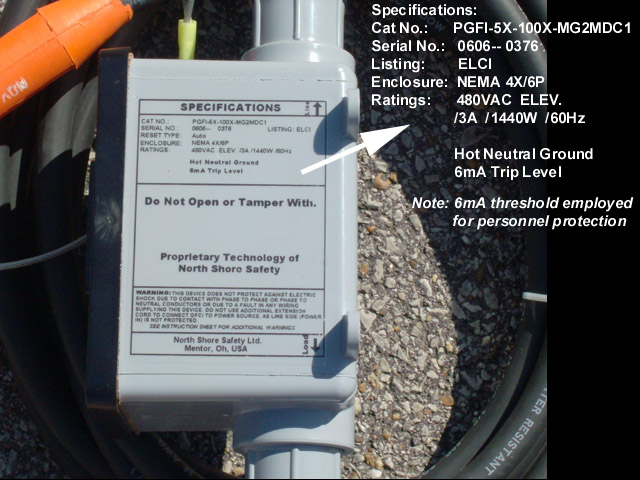 |
Avoiding Electrical Hazards
Electrical Hazards are much too common in public areas This
hazard was identified at Austin Convention Center (Austin, TX). An
ELCI would offer protection.
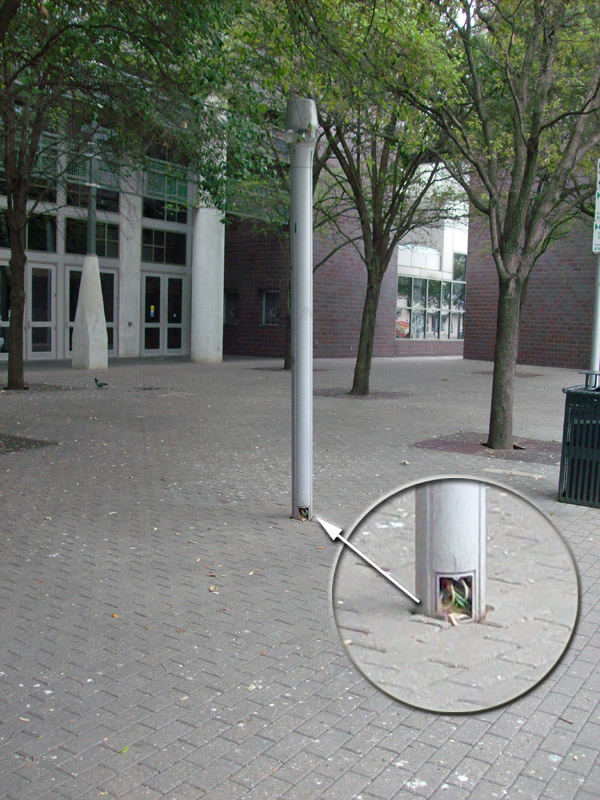
An open transformer base with a child's
baseball seen inside seen in the photo below (Philidelphia, PA).
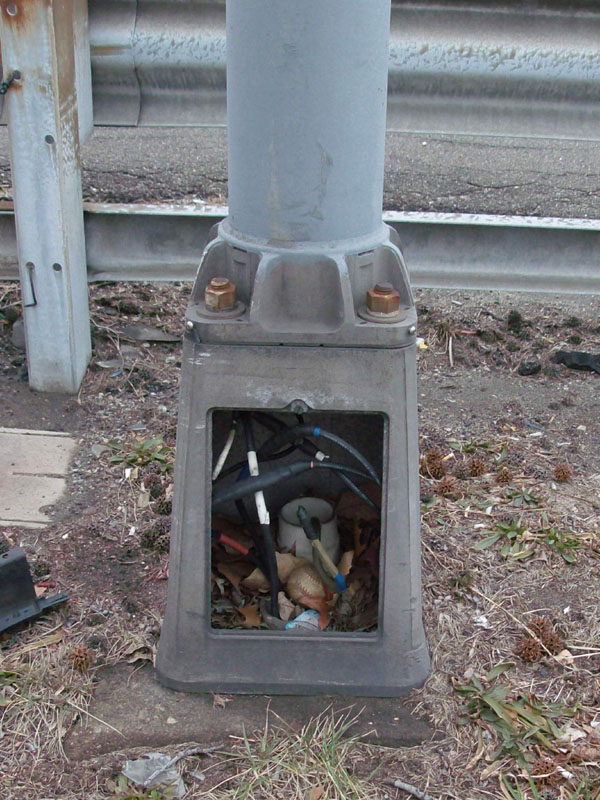
Studies Published in the IMSA Journal (September - October, 2008)
estimated 1 in every 337 lighting poles posed an electrical hazard. That
did not include utility poles, electrical junction boxes, traffic signal
poles, cross-walk signs and other sources that have been found also posing
an electrical hazard to the public. The New York Times reported that
after an incident in New York City where a woman was electrocuted on a
sidewalk while walking her dogs, prompted city wide inspections of
thousands of construction plates, manhole covers, light poles and
street-level electrical boxes throughout the city. Con Edison (NY power
company) found more than 300 locations with stray voltage, including 30
with more than 50 volts, which can be enough to kill.
|


 ELCI
stands for "Equipment (sometimes "Earth") Leakage Circuit Interrupter",
and is a device intended to mitigate ground fault leakage specifically for
the protection of equipment. A "GFCI" (Ground Fault Circuit Interrupter)
is essentially the same as an "ELCI", but for the most part differ in trip
threshold of leakage current and/or circuit voltage. A "GFCI" indicates
that "Personnel" protection is being provided. This calls for a trip
threshold of 4 to 6 mA with a maximum response time of 25ms and circuit
voltage from any single current carrying conductor to Ground cannot exceed
150V. Thus, even if a 4 to 6 mA trip threshold is employed, on a 480V
circuit, or even a 240V elevated (L1, N), providing personnel protection
is not feasible. In order to provide personnel the greatest level of
protection given circuit criteria, use of an "ELCI" is prescribed for
personnel protection. Other applications for "ELCI" devices may call for
higher trip thresholds of 10, 30, or even 100mA as baseline leakage as
some of these applications may well exceed 6mA when a load device is
functioning properly.
ELCI
stands for "Equipment (sometimes "Earth") Leakage Circuit Interrupter",
and is a device intended to mitigate ground fault leakage specifically for
the protection of equipment. A "GFCI" (Ground Fault Circuit Interrupter)
is essentially the same as an "ELCI", but for the most part differ in trip
threshold of leakage current and/or circuit voltage. A "GFCI" indicates
that "Personnel" protection is being provided. This calls for a trip
threshold of 4 to 6 mA with a maximum response time of 25ms and circuit
voltage from any single current carrying conductor to Ground cannot exceed
150V. Thus, even if a 4 to 6 mA trip threshold is employed, on a 480V
circuit, or even a 240V elevated (L1, N), providing personnel protection
is not feasible. In order to provide personnel the greatest level of
protection given circuit criteria, use of an "ELCI" is prescribed for
personnel protection. Other applications for "ELCI" devices may call for
higher trip thresholds of 10, 30, or even 100mA as baseline leakage as
some of these applications may well exceed 6mA when a load device is
functioning properly. An
ELCI can easily be employed or retrofitted into existing MG Squared
DOTPLUG systems. In fact, in Miami Dade County Florida, hundreds of DOTPLUG systems have been either ordered or retrofitted with ELCI systems.
An
ELCI can easily be employed or retrofitted into existing MG Squared
DOTPLUG systems. In fact, in Miami Dade County Florida, hundreds of DOTPLUG systems have been either ordered or retrofitted with ELCI systems.

